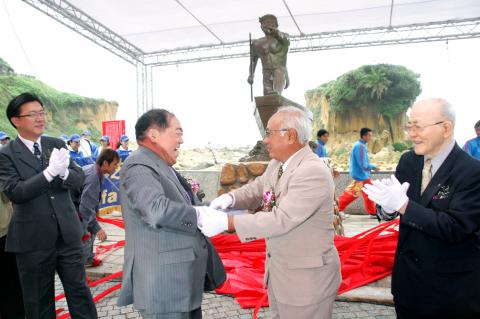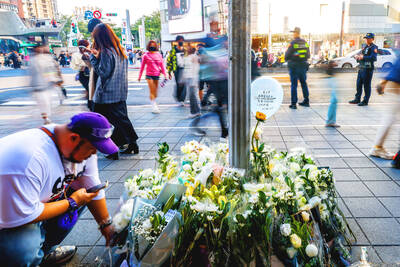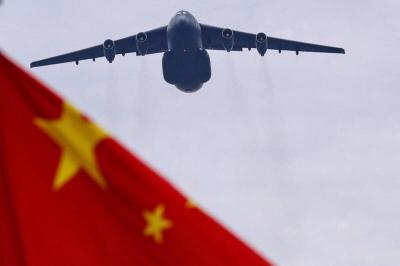Braving strong winds, rain and waves pounding the shore, officials and residents from Keelung and Japan’s Okinawa Prefecture yesterday jointly unveiled a statue of an Okinawan fisherman with cheers, music and words of friendship to commemorate Okinawans who died during the 228 Incident.
The ceremony started with a Buddhist rite, hosted by the head monk from Seikoji Temple in Okinawa, at Wanshantang — a small temple with urns containing bones and ashes of people of unknown identity or those who died without descendants — near the monument on Keelung’s Heping Island (和平島), which is just off Taiwan proper.
Bodies of Okinawan fishermen, including more than 30 of them who were killed by Chinese Nationalist Party (KMT) troops in the 228 Incident, were buried at Wanshantang.

Photo: Loa Iok-sin, Taipei Times
The 228 Incident refers to the large-scale uprising across the island in 1947 against the KMT regime, which was put down in a violent crackdown.
“We’ve always heard that some of our ancestors are here in Keelung and the people of the city have always remembered them in religious rites,” the monk said. “We’re holding a religious rite and have erected a monument here to comfort the spirits of our ancestors.”
“Meanwhile, we would also like to express our gratitude to the people of Keelung,” the monk added.
Chou Chen-tsai (周振才), a board member of the 228 Care Association, said that from about 1905 to the end of World War II, as many as 500 fishermen from Okinawa, whose former name was Ryukyu, had settled on Heping Island, forming a “Ryukyu village” there, and lived side by side with Taiwanese.
Many Okinawan fishermen stayed after the end of the war and some were killed during the massacre in 1947.
“That there were Okinawan victims of the 228 Incident are not known among the public, but we’ve always heard about it from locals. So, around eight years ago, organizations of the 228 Incident and historians launched a research project in both Taiwan and Okinawa and have confirmed it as fact,” Chou said.
“That’s why we’re erecting a monument here, not only to remember the deceased, but also to remind the public about the forgotten history,” Chou added.
The religious rite was followed by a ceremony to unveil the monument by Keelung Mayor Chang Tong-rong (張通榮) and Toshihiko Simoji, mayor of Miyakojima City in Okinawa Prefecture, where many of the Okinawan fishermen who settled on Heping Island came from.
The mayors thanked each other for their help in erecting the statue and expressed the hope that the monument would help to enhance exchanges between the two cities, which were quite frequent before 1945.
Many Okinawans whose ancestors had once lived on Heping Island also attended the ceremony — among them was Shiosei Yashumoto, whose great-uncle, Chouzou Uchima, lived on Heping Island from 1905 to 1945, and was the model for the fisherman statue.
“My great uncle lived in Taiwan from 1905 to 1945. He was a good friend of Taiwanese, he taught them some fishing techniques unique to Okinawa and gave his Taiwanese friends fish during wartime when the [Japanese colonial] government prohibited selling fish to the Taiwanese,” Yashumoto said through a translator. “He was even arrested for that, but he was released by arguing that he didn’t ‘sell’ the fish, rather, people took it from him for free.”

HORROR STORIES: One victim recounted not realizing they had been stabbed and seeing people bleeding, while another recalled breaking down in tears after fleeing A man on Friday died after he tried to fight the knife-wielding suspect who went on a stabbing spree near two of Taipei’s busiest metro stations, Taipei Mayor Chiang Wan-an (蔣萬安) said. The 57-year-old man, identified by his family name, Yu (余), encountered the suspect at Exit M7 of Taipei Main Station and immediately tried to stop him, but was fatally wounded and later died, Chiang said, calling the incident “heartbreaking.” Yu’s family would receive at least NT$5 million (US$158,584) in compensation through the Taipei Rapid Transit Corp’s (TRTC) insurance coverage, he said after convening an emergency security response meeting yesterday morning. National

Beijing could eventually see a full amphibious invasion of Taiwan as the only "prudent" way to bring about unification, the US Department of Defense said in a newly released annual report to Congress. The Pentagon's "Annual Report to Congress: Military and Security Developments Involving the People's Republic of China 2025," was in many ways similar to last year’s report but reorganized the analysis of the options China has to take over Taiwan. Generally, according to the report, Chinese leaders view the People's Liberation Army's (PLA) capabilities for a Taiwan campaign as improving, but they remain uncertain about its readiness to successfully seize

Taiwan has overtaken South Korea this year in per capita income for the first time in 23 years, IMF data showed. Per capita income is a nation’s GDP divided by the total population, used to compare average wealth levels across countries. Taiwan also beat Japan this year on per capita income, after surpassing it for the first time last year, US magazine Newsweek reported yesterday. Across Asia, Taiwan ranked fourth for per capita income at US$37,827 this year due to sustained economic growth, the report said. In the top three spots were Singapore, Macau and Hong Kong, it said. South

PLANNED: The suspect visited the crime scene before the killings, seeking information on how to access the roof, and had extensively researched a 2014 stabbing incident The suspect in a stabbing attack that killed three people and injured 11 in Taipei on Friday had planned the assault and set fires at other locations earlier in the day, law enforcement officials said yesterday. National Police Agency (NPA) Director-General Chang Jung-hsin (張榮興) said the suspect, a 27-year-old man named Chang Wen (張文), began the attacks at 3:40pm, first setting off smoke bombs on a road, damaging cars and motorbikes. Earlier, Chang Wen set fire to a rental room where he was staying on Gongyuan Road in Zhongzheng District (中正), Chang Jung-hsin said. The suspect later threw smoke grenades near two exits